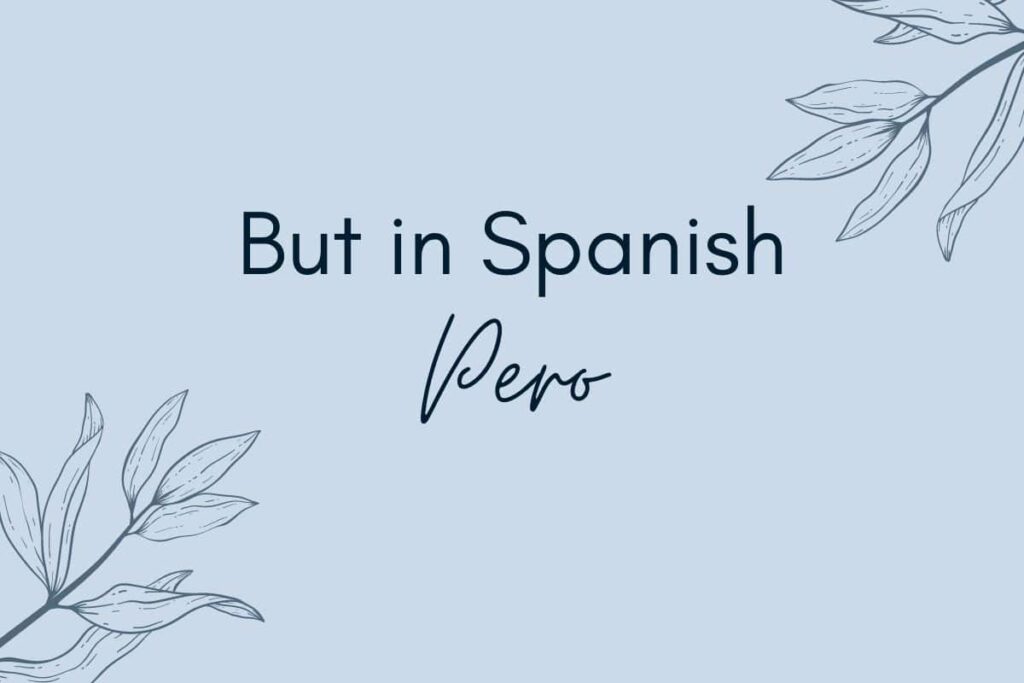3 Ways to Say But in Spanish – No ifs ands or buts!
“But” is one of the most used words in English and is one of the 100 most important Spanish words to learn. This conjunction is used to express a contrast between concepts, but it is not its only function. (See? We’re using it already!)
But “but” is something of a wild card: it can be used in many situations! Now… does this also happen in Spanish? The answer is yes: the word pero, which is but in Spanish, can be used in several contexts. However, other words in Spanish also mean “but”. In this article, we will learn how to say “but” in Spanish and the correct ways to use it in different situations.
All the Ways to Say But in Spanish

Pero: The Most Well-Known But
The most common way (and, surely, the one you have heard the most) of saying “but” in Spanish is pero. Like all conjunctions, its function is to act as a link between two sentences or two words. In this case, its main objective is to present two concepts as opposites. Let’s see an example of the use of “but” in Spanish.
Spanish
- Anunciaron lluvia en el noticiero, pero está soleado.
- Entiendo tu punto, Carlos, pero no lo comparto.
English
- They announced rain on the news, but it’s sunny.
- I understand your point, Carlos, but I don’t agree with it.
As you can see, in this case, there are virtually no differences in the construction of the sentences in English and Spanish. Actually, we could say that here pero is used in the same way. But… what happens if we raise the level of difficulty a little?
Pero as an interjection
Something very common in Spanish is to use pero at the beginning of a sentence, to emphasize what will be said next. These types of sentences are interjections: phrases that, pronounced in an exclamatory tone, express a state of mind or a situation to which we must pay attention. In these cases, pero does not work exactly the same as “but”. Let’s see some examples of pero in interjections:
Spanish
- Pero ¡qué calor!
- Pero ¡cuánta gente ha venido a tu fiesta!
English
- Well, it’s so hot!
- Just look at how many people have come to your party!
And don’t be surprised if you simply hear the word ¡Pero! In some countries, such as Argentina and Uruguay, it is used as an interjection by itself and acts as a complaint or a call for attention, like “Oh!”. For example:
Spanish
Niño: Mamá, rompí tu jarrón favorito.
Mamá: ¡Pero!
English
Child: Mom, I broke your favorite vase.
Mom: ¡Oh!
How to say But Why in Spanish
Finally, you might be wondering how to say “but why?” in Spanish. The correct way to do it is Pero ¿por qué? Remember: por qué is written separately and with a mark on top of the “e”, because it’s a question. Meanwhile, the answers to por qué (“why”) begin with the word porque (because), which is written all together and without accent marks.
Read next: Por qué vs Porque: What’s the difference?
Sino: Meaning But Rather
The second most common way of saying “but” in Spanish is sino. This word basically serves to introduce an affirmation that opposes a previous negation. It is used in the way in English you would use the term “but rather”. Let’s break it down.
Imagine you split a sentence into two parts, and the second part completely negates the previous part. In general, a sentence of this type could be given as a response to an erroneous sentence. Let’s see a dialogue with the word sino being used in these cases.
Spanish
Carla: ¿María vive en Asunción, la capital de Paraguay?
Sandra: ¡No! María no es paraguaya, sino uruguaya.
English
Carla: Does María live in Asunción, the capital of Paraguay?
Sandra: No! María is not Paraguayan, but Uruguayan.
Let’s see another example:
Spanish
Carla: ¿Quieres que te pase a buscar por la oficina para ir a almorzar?
Sandra: Hoy no iré a la oficina, sino que trabajaré desde casa.
English
Carla: Do you want me to pick you up by the office to go to lunch?
Sandra: Today I won’t go to the office, but I will work from home
Salvo, Excepto, Menos: Meaning Except
In English, “but” is also used to indicate an exception within a sentence. In Spanish, the word pero wouldn’t be appropriate in these situations. If we want to say, for example, “Everybody has arrived early but Juan”, we wouldn’t say Todos llegaron temprano pero Juan. Instead, there are several words we could use in these cases: salvo, excepto and menos:
- Todo el mundo ha llegado temprano menos Juan.
- Todo el mundo ha llegado temprano excepto Juan.
- Todo el mundo ha llegado temprano salvo Juan.
Conclusion
“But” is a short, but very useful word that is important to communicating effectively. We don’t realize how often we use it, but once you think about it, you’ll see that we use it all the time!
As we’ve seen, the word pero is used in most situations, but other words – such as sino, excepto, salvo or menos – are also used, depending on the situation.
Now that you know how to say “but” in Spanish, you will be able to have much more fluid conversations with your Spanish-speaking friends!






